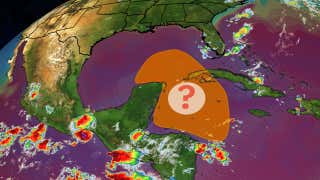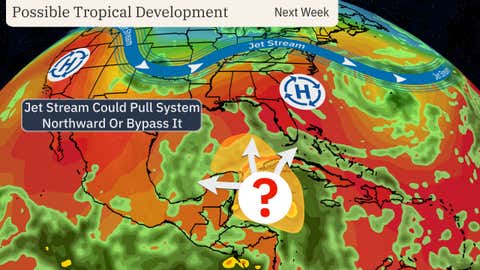Possible Caribbean, Gulf Tropical Development Monitored By National Hurricane Center

Possible Named Storm In Caribbean Next Week
The National Hurricane Center is monitoring several areas for development in the Atlantic, but the one in the Caribbean is especially worth watching. Here’s the latest forecast.
At a Glance- The National Hurricane Center is monitoring the northwest Caribbean and Gulf for tropical development.
- A tropical depression or storm could form near this region sometime next week.
- Details on its possible future are uncertain, but the U.S. Gulf Coast should stay updated.
Sign up for the Morning Brief email newsletter to get weekday updates from The Weather Channel and our meteorologists.
An area from the northwest Caribbean to the southern Gulf of Mexico is being watched closely for the possible formation of a tropical storm next week. It's too early for specific details, but the U.S. Gulf Coast should watch closely to see how this forecast evolves in the coming days.
The area to watch: The National Hurricane Center has outlined an area between Cuba and Mexico's Yucatan Peninsula for the possible formation of a tropical depression or storm in the next seven days. At this time, there is no system to track in this region, as the general lack of storminess in the satellite view below shows.
What could happen by early next week is that a broad area of low pressure forms in association with what's called the Central American Gyre, giving rise to increasingly stormy weather.

(The possible area of tropical development according to the latest National Hurricane Center outlook are shown by the polygon, color-coded by the chance of development over the next seven days. An "X" indicates the location of a current disturbance if one already exists.)
When a tropical storm could develop: The middle of next week is when the window for formation of a tropical depression or storm open in the northwest Caribbean or southern Gulf from this broad area of low pressure. The next storm names are Helene and Isaac.
For that to happen, the broader low would need to spin off a more well-defined low-pressure system with persistent shower and thunderstorm activity. This typically happens over the course of multiple days after a gyre forms.
If a storm forms, here's where it might track: This possible storm could track north or northeast toward the U.S. Gulf Coast or northwest toward the Yucatan Peninsula and then the southwest Gulf.
Exactly when and where the system forms, assuming it does at all, and how much of an influence there is from a southward plunge of the jet stream tracking eastward over the central U.S. next week will play a role in where it tracks.
The greater the influence from that jet stream, the more likely the system would get drawn north toward the U.S. Gulf Coast. If it has less of an influence, then the system might move northwest toward the Mexico's Yucatan Peninsula and the southwest Gulf, with its future track beyond that point uncertain.
T?he timing of any potential U.S. impact might not be until at the earliest late next week or beyond.

Could it become a hurricane? It's certainly possible. Oceanic heat content is one favorable ingredient for intensification, and the map below shows there is plenty of deep, warm water in the northwest Caribbean and parts of the Gulf of Mexico.
But there are other factors that also matter, like whether or not the upper-level wind pattern is favorable for strengthening. It’s also unknown if any nearby dry air or land interaction, such as with Mexico's Yucatan Peninsula, could be hindrances to intensification.
F?or now, interests along the U.S. Gulf Coast should monitor the situation closely while also making sure hurricane preparedness plans are in place. Check back with us at weather.com and The Weather Channel app for updates through the weekend and beyond as we fill in more details on what to expect.

(This map shows areas of not only warm water, but warm, deep water that is one ingredient to fuel developing and active tropical cyclones.)
Chris Dolce has been a senior meteorologist with weather.com for over 10 years after beginning his career with The Weather Channel in the early 2000s. |








